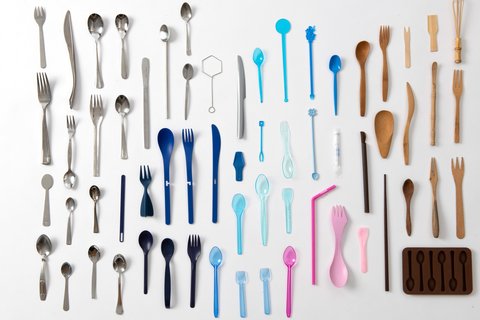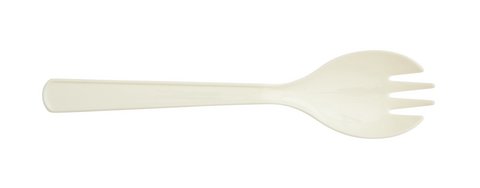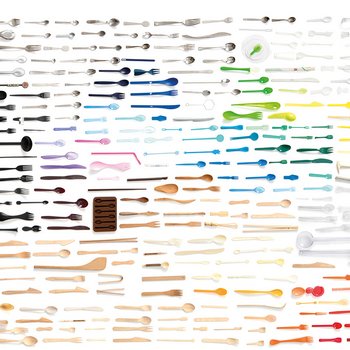
“The approach to food is essentially tactile. As in all of India, Bengalis eat everything with their fingers ... What, after all, could be better than the sensitive fingers to provide an awareness of texture which becomes as important as that felt by the tongue? The various mashed vegetables or different rice or varieties of fish we eat are all appreciated by the fingers before they enter the mouth.” This is what the author Chitrita Banerji writes in her 1991 book “Life and Food in Bengal”.
Was food more enjoyable if no troublesome tools were required to convey it to your mouth? That is certainly how the Baroque author Moscherosch saw it 300 years earlier, on another continent: “How shall I savour the lettuce if I do not eat it with my fingers?”

SPOON ARCHAEOLOGY - POSTER © PETER ECKART, KAI LINKE, FOTO: Pia Scharf
Using cutlery to eat is a relatively new custom in Europe. Knives were kept in the kitchen to cut up food when preparing it. Large two-pronged forks and ladles were also used in kitchens, but not at the dining table. In the Middle Ages, everyone carried a knife of their own which they used to eat, cutting chunks of meat or other solids from the large serving platter if they could not be broken off with the hands. A particularly hard, four-day-old slice of bread was often used as a plate. The chunks could be cut smaller on that before putting them in your mouth with your hand, or sometimes also your knife. Anything too runny to stay on the slice of bread was slurped straight from the big bowl, or there were smaller bowls, usually shared by two people. However, mashed food tended to be served rather than soup, and that could be picked up in your fingers.

SPOON ARCHAEOLOGY - POSTER © PETER ECKART, KAI LINKE, FOTO: Pia Scharf
Tablecloths arrived in Charlemagne’s times as a kind of large serviette that could be used to wipe grease off your fingers. At the end of the meal, the bread that had soaked up all kinds of delicious sauces itself made a tasty delicacy. In wealthier households, it was eaten by the servants, or distributed to the poor, who waited for it outside the door when a feast was held.
Let us watch an emperor dining with his fingers: Charles V eating a meal in 1547. In his book “Alltags- und Festspeisen” (Everyday Food and Feasts), Günter Wiegelmann quotes an eyewitness report: “I often saw the Emperor eat at Imperial meetings ... His food was not cut for him, and neither did he use the knife a great deal. Instead, he cut many pieces of bread as big as he could put in his mouth at one time. He used the knife to slice off a piece of the dish he wanted to eat, then broke the piece apart with his fingers, pulled the bowl under his chin and ate so naturally, yet neatly and cleanly, that you could see how much he savoured it.”

SPOON ARCHAEOLOGY - POSTER © PETER ECKART, KAI LINKE, FOTO: Pia Scharf
Spoons were already being used at the table by that time. At a large table, they were shared, cleaned on the bread or cloth after each use, then passed on. A single cup was also generally passed from one person to another to drink from. In about the fourteenth century, the custom was increasingly adopted of everyone having their own spoon to serve themselves from a shared bowl. In simpler households, they were usually home-made spoons carved out of wood, while those in wealthier households were made of tin. When the uncomplicated nature of a shared meal was replaced by individual soup bowls and serving spoons, books of etiquette began to appear, explaining how to use a spoon of this kind. England, at the end of the nineteenth century: “Now I must just say (as this book is written for those who do not profess to know much of society) that you should eat your soup from the side of your spoon, not take it from the point.” Germany, at the start of the twentieth century: “The spoon is raised not with the side toward the mouth, but with the point.”
In the countryside, old customs were preserved longer. At a conference on ethnological food research in Helsinki in 1973, one participant reported of his native Norway: “In many parts of the countryside, only spoons and knives were used until the second half of the nineteenth century, so stews were very widespread, while gruel or soup was eaten from a shared bowl. The meat was cut into suitably sized chunks and cooked with turnips, cabbage or peas. At the table, each person took a piece of meat from the bowl, placed it on a wooden plate or a flat slice of bread, cut it up and used the knife to lift the pieces into their mouth. Meanwhile, the broth was sipped from the bowl.”

SPOON ARCHAEOLOGY - POSTER © PETER ECKART, KAI LINKE, FOTO: Pia Scharf
The fork arrived at the table even later than the spoon, and was initially derided. When King Henri III of France introduced forks to his court at the end of the sixteenth century, an anonymous satire entitled “Island of Hermaphrodites” read: “they lifted the meat to their mouths with their forks, stretching out their necks and leaning their whole bodies over their plates ... for it is forbidden in this country to touch the meat with the hands; however difficult it may be, they prefer this little pronged instrument to touch their lips rather than their hands... Afterwards, there were artichokes, asparagus, peas and beans, and it was a pleasure to watch how they ate them with the forks, as those who were not as good at it dropped most of it into the bowl, onto the plate or on the way to their mouths.”
Another century later, Louis XIV refused to use a fork, and forbade the princes from doing so in his presence, as his sister-in-law Liselotte of the Palatinate reported back to Germany, adding: “No-one has ever forbidden me from doing any such thing; throughout my life, I have always only ever used my knife and my five fingers.” She did not even require a spoon!
Also of interest:
What’s being left by the fast-food culture
Disposable plastic cutlery is an icon of the global throwaway culture. It has been banned in the EU since July 3, 2021. Based on the collection of designers Peter Eckart and Kai Linke, the exhibition "Spoon Archaeology" at the Kunstgewerbemuseum explores this topic.

Spoon Archaeology meets Lunch for Locals
The Spoon Archaeology exhibition is designed as a reaction to the EU ban on single-use tableware. But what will replace it? The designers Peter Eckart and Kai Linke, whose cutlery collections are on display in the Kunstgewerbemuseum this year, asked themselves that very question. It has to be sustainable and, of course, fit for purpose. The answer they have come up with has a far less futuristic ring to it than you might expect: the human hand. We join the Palais Café to try it out.

The Emancipation of the Kitchen
Food culture is not only reflected in the cutlery we use to convey food to our mouths, but also in the rooms we prepare it in. However, it is only in the course of the last century that the kitchen has become an integral part of our living spaces. As a design object, it has not only shaped our idea of the value of food and cooking, while at the same time it bears witness to different stages and different systems in which this cultural ascent has been negotiated. Agata Szydłowska on the emancipation of the kitchen.
